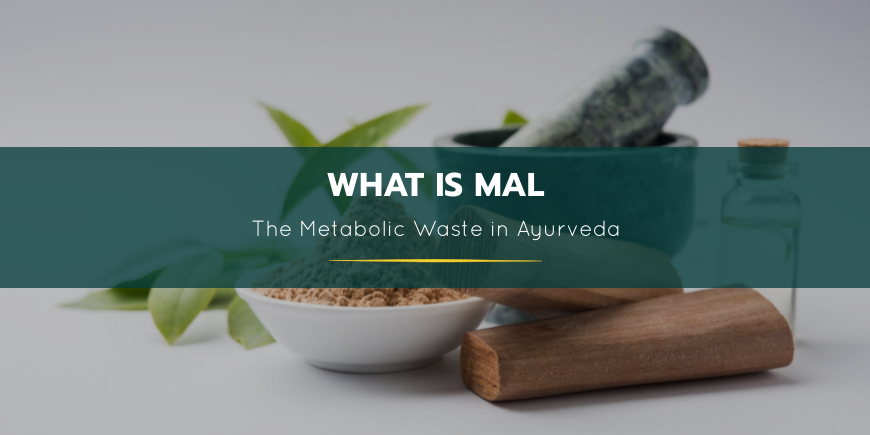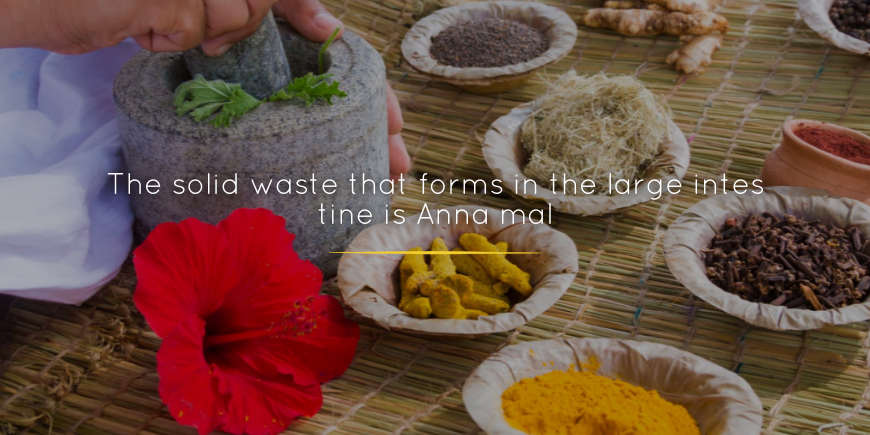
Introduction
In the previous blogs, we read about dosha and dhatus. Doshas are the biophysical energies that run the body and dhatu (tissue systems) are the tools for doshas. The third most important part of metabolism that keeps the body clean is Mal or the excretory products.
However, like the way, a fire produces ash and smoke, every process produces some by-product or waste. The body metabolism also produces waste at each stage of biochemical conversion. Each dhatu produces distinct waste as it upgrades to the higher dhatu. (Reference blog – Dhatuvagni).
And these metabolic wastes play a crucial role in our metabolism.
What is Mal?
The definition of mal says –Malinikarananmalh
It means the substances that soil the body are called mal. Another definition states that mal help to clean the body. Both definitions are different aspects of the same process.
As there can be no life sustainance without food, so is it without excretion. Mal means the one that taints/defiles, foul, wastes, or undesired part. Ayurveda states that Mal “gratifies the body by leaving gracefully”. Every person suffering from constipation or loose motions will best appreciate this concept!
Types of Mal
The Mals produced in the first stage of metabolism are the feces, urine, and sweat. However, according to Ayurveda, Mal is not only the waste that is produced after digestion and absorption in the alimentary canal. Mal includes all the waste products formed at different stages of metabolism.
The best part of the essence of each dhatu is converted into the higher dhatu. But the lesser part is converted to mal or excreta and is removed from the body.
There are two main categories of mal
- Anna mal
- Dhatu mal
Anna mal
Anna means food/grains. Anna mal is the primary waste in the body. It is of two types – solid feces and urine.
Dhatu mal
There is a constant conversion of one dhatu (tissue system) to another dhatu in a specific sequence. Dhatu mal forms as waste in this conversion process. There are seven major dhatu or tissue conversion processes that produce waste.
- When food forms rasadhatu, it produces kapha as by product, mucus and lymph as waste;
- When rasa dhatu (digested juice) forms raktadhatu (blood), the process results in the production of pitta or bile as a by-product.
- The conversion of rakta(blood) to mansadhatu(muscle tissue) leads to the formation of ear wax, and nasal mucus.
- The mansadhatu(muscular tissue) upgrades to form meda dhatu (fat tissue/Adipose tissue). This conversion leads to the production of sweat.
- When the meda dhatu (fat tissue/Adipose tissue) forms the higher tissue asthidhatu (bony tissue), it also produces hair, beard, body hair, and nails as a waste ofasthidhatu.
- The asthi dhatu (bony tissue) mallows to form the next tissue majja (marrows). This conversion leads to the formation of oily secretions/moisture present in the eyes, skin, and fecal matter.
- Majja (marrows) transforms to produce the highest dhatu/tissue in the body – shukra or the reproductive tissue. Shukra production occurs in both males and females. Shukra is the only dhatu that forms no waste. However, some ancient Ayurveda masters like Dalhan believed that shukra dhatu forms mustache and bread as waste products.
- Shukra also transforms into Ojas. Ojas is not a physical entity. It is the life force or the pure energy that powers the physical existence of a living being.
These waste products are not exactly wasteful. The body makes very efficient use of this waste before final elimination. These waste products are crucial in many management of various metabolic functions. I will elaborate on each dhatu mal and its formation in the coming blogs.
Summary
Dhatu | DhatuMal |
Rasa (Chyle) | Kapha (Mucus), Lasika (lymph) |
Rakta (Blood) | Pitta (Bile) |
Mansa (Muscles) | Kha Mal (Ear wax, nose mucus) |
Meda (Adipose tissue) | Sweda (Sweat) |
Asthi (Bones) | Kesh (Hair), Nakh (Nails) |
Majja (Marrows) | Akshi-tvak-vit Sneha (Oily moisture in eyes, skin, and fecal matter) |
Shukra (Reproductive tissue) | None |
Importance of Mal
Anna Mal
Fecal Matter (Purish)
The solid waste that forms in the large intestine is Anna mal. The stool appears to be a waste product that needs elimination from the body. However, stools perform important physiological functions inside the body before excretion.
Fecal matter creates heat inside the body through fermentation. It contributes to the heat generation and temperature management system of the body. Ayurveda says that the physician must protect the fecal matter in a weak patient, esp. in the case of debilitating diseases like tuberculosis. Because fecal matter in a weak person is an important point of heat generation.
Also, fecal matter helps in temperature management. It takes away extra heat from the body through excretion.
Fecal matter helps the large intestine retain its shape.

Bacteriotherapy
It also promotes the growth of healthy gut microbes. The new science Bacteriotherapy has its roots in the microbiota promoting the role of feces.A course of antibiotics kills the good bacteria present in the colon/large intestine. This event leads to the uncontrolled growth of harmful bacteria Clostridium difficile.
With the rampant use of antibiotics, Clostridium difficile may damage the intestinal lining and cause a condition called Clostridium difficile colitis. This infection may lead to life-threatening complications like toxic megacolon.
It is useless to revert to antibiotic treatment in such cases. In more than 60% of cases, antibiotic treatment results in recurrent infection. Instead, the new treatment approach Bacteriotherapy helps to replace the fecal matter from a healthy donor. The bottom line is that feces is extremely important for our gut health.
Urine (Mutra)
Urine performs some very important metabolic functions.
By eliminating the excess water in the body, it helps to maintain the proper blood constitution. It also eliminates toxins like uric acid, excess salt, and other metabolic toxins.
Urine also helps to reduce body temperature.
Dhatu Mal
These waste products form inside the body during the conversion of different dhatu. However, their final elimination happens through solid feces and urine.
These dhatu transformations require more research-based evidence for validation.
Waste of Rasa Dhatu (chyle/digested juice)
Kapha (Mucus)
Ayurveda says that pitta dosha colors the rasa dhatu (digested juice) to form blood. This process happens in the liver. The blood is warm and pitta dominant, whereas rasa is kapha dominant. The undesired part of rasa with kapha dominance becomes mucus. This mucus is extremely important as it forms the tissue fluid, lines the various channels like the intestines, protects the vital organs with a fluid shock-absorbing system (pleura around the lungs, pericardium around heart, etc.). This mucus moisturizes all the body tissue and prevents dryness lead deterioration.
Lasika (lymph)
Rasa conversion to rakta (blood) produces another waste – Lasika or lymph. Blood formation is not a single-step process. It happens at different sites of the body. For example, the kidneys filter the blood and help to retain its normal constitution. Similarly, lymph formation gradually occurs as blood oozes out of the fine capillaries. The venous system transports lymph back to the circulatory system, where the waste part is finally excreted through urine.
Waste of Rakta Dhatu (blood)
Pitta (Bile)
As rakta (blood) condenses to form the muscular tissue, the dominant pitta dosha gives way to kapha(dominant dosha in muscle tissue). This excess pitta energy segregates in the form of bile. This bile assists the digestion before its elimination through along with the fecal matter.
Waste of Mansa Dhatu (muscular tissue)
Kha Mal (Ear wax, nose mucus)
The word “kha” means space. We have a lot of hollow cavities in our bodies.
When the blood converts to the higher tissue mansa or the muscular tissue, then the excess fat and waste convert to form kha mal or the waxy layer that lines up external hollow cavities. This waste forms a waterproof protective layer inside the ear lobe, nasal cavity, oral cavity, and vaginal cavity. All these cavities are entrances to the body.
This protective layer prevents dryness or pathogenic infestation in the internal cavities.
Waste of Meda Dhatu (fat/adipose tissue)
Sweda (Sweat)
As the mansa or the muscular tissue upgrades to form the fatty tissue, it forms sweda or sweat as waste. As the muscular tissue dissolves in the medagni (tissue fire that forms the fat tissue), it mallows to form the fat tissue. The fire element segregates in the form of sweat.
Sweat is essential for temperature management. It evaporates from the skin surface and instantaneously reduces the body temperature. This temperature regulatory mechanism is esp. useful in a hot climate.
Sweat also protects the skin from pathogens due to its saline constitution. It is an excellent excretory doorway for all peripheral toxins.
Waste of Asthi Dhatu (Bony tissue)
Kesh (Hair), Nakh (Nails)
As the fatty tissue hardens to become asthi or bone tissue, the leftover raw material becomes nails and hair. Nails and hair serve protective purposes. At the same time, they remove the unwanted material from the body.
A nail or hair can give a good indication of bone health and possible disorders because the raw materials of the nails and hair are the same as those found in the bones.
Waste of Majja Dhatu
Akshi-tvak-vit Sneha (Oily moisture in eyes, skin, and fecal matter)
Asthi or the bony tissue dissolves in the metabolic fire (majjagni) and forms higher tissue majja or the marrow. The marrow tissue is unctuous and its waste also contains the same quality. However, this waste is more useful and refined compared to the waste of lower tissues.
Therefore, this unctuous waste lubricates the eyes, skin, and fecal matter. (akshi = eyes, tvak =skin, vit = stool, sneh = moisture/oil)
A deficiency in this waste results in dryness in the eyes, skin, and large intestine. It may lead to constipation, bloating, or stomachache.
Take Away
Mal or the waste has many types in Ayurveda. Ayurvedic waste concept of waste goes beyond solid fecal matter and urine. According to Ayurveda, mucus, lymph, bile, ear wax, hair, nails are all part of metabolic waste. However, all these waste substances have important physiological roles to play before elimination from the body.
This blog is a sneak peek into the immense treasure of Ayurveda. There are multiple aspects of waste management in the body that need more research. I would love to research the link between bacteriotherapy and the enormous importance of cow dung and cow urine in Ayurveda.
I hope that this information helps everyone. Thanks for reading!
Are you passionate about holistic health and natural healing? Our Ayurveda Certification Course offers you the opportunity to dive deep into the ancient wisdom of Ayurveda and become a certified. Transform your life and the lives of others by enrolling in our course today.
Responses